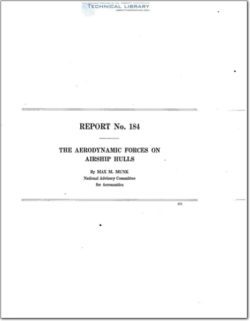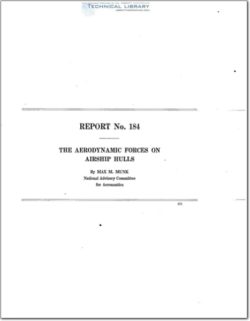naca-report-184

- Version
- 194 Downloads
- 1.42 MB File Size
- 1 File Count
- April 19, 2016 Create Date
- April 19, 2016 Last Updated
National Advisory Committee for Aeronautics, Report - The Aerodynamic Forces on Airship Hulls

This report describes the new method for making computations in connection with the
study of rigid airships, which was used in the investigation of Navy’s ZR—I by the special
subcommittee of the National Advisory Committee for Aeronautics appointed for this purpose.
It presents the general theory of the air forces on airship hulls of the type mentioned, and an
attempt has been made to develop the! results from the very fundamentals of mechanics, with-
out reference to some of the modern highly developed conceptions, which may not yet be
thoroughly known to a reader uninitiated into modern aerodynamics, and which may perhaps
for all times remain restricted to a small number of specialists.
The student of the motion of solids in air will find advantage in first neglecting the
viscosity and compressibility of the latter. The influence of these two properties of air are
better studied after the student has become thoroughly familiar with the simplified problem.
The results are then to be corrected and modified; but in most cases they remain substantially
valid.
Accordingly I begin with the discussion of the general properties of aerodynamic flows
produced by the motion of one or more solid bodies within a perfect fluid otherwise at rest.
In order to be able to apply the general laws of mechanics to fluid mot-ion I suppose the air to
be divided into particles so small that the diflerences of velocity at different. points of one par—
ticle can be neglected. This is always possible, as sudden changes of velocity do not occur
in actual flows nor in the kind of flows dealt with at present. The term “flow” denotes the
entire distribution of velocity in each case.
With aerodynamic flows exteglal volume forces (that is, forces uniformly distributed over
the volume) do not occur. The only force. of this character which could be supposed to influ-
ence the flow is gravity. It is neutralized by the decrease of pressure with increasing altitude,
and both gravity and pressure decrease‘can be omitted without injury to the result. This
does not refer to aerostatic forces such as the buoyancy of an airship, but the aerostatic forces
are not a subject of this paper.
| File | Action |
|---|---|
| naca-report-184 The Aerodynamic Forces on Airship Hulls.pdf | Download |
Comment On This Post